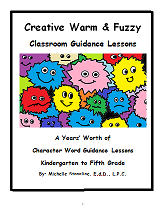Helping Kids Behave
Part Three
Dr. Chapman points out that a child works at the subconscious level, but their behavior is motivated by their own emotional needs. If these needs are not met they may “violate acceptable standards, express anger toward parents”, --- (and in this author’s experience others in authority) --- “and seek love in inappropriate places.”
He further notes that a colleague, Dr. Campbell, indicates that he has never treated an adolescent for sexual misconduct whose emotional love needs were met by the parents. This is not to say you need to become a second parent, but there are ways you can show approval and caring for students.
You will find that those students who are the worst behavior problems are the ones who most need to know someone cares. But how do you tell which language a child speaks? Chapman and Campbell (1997) state that you must listen and pay attention to what they want you to do. If the child always wants you to do something with them, then his language may be quality time.
If the child makes presents for people, then her language may be receiving gifts. If they are always trying to help, then their language may be acts of service. If he always tells people how nice they look or gives compliments or is “angling for compliments” then his language may be words of affirmation.
If she touches a lot, then the language may be physical touch. Children and adults may also have more than one language. In addition Chapman and Campbell note that a child’s language may change and that young children need to hear all the languages both for support and to teach them how to speak the other languages to other people. In this way we learn to show caring to others in ways the other person readily understands and appreciates.
One therefore needs to be aware and try to speak all the languages that
are spoken. Again, what the authors are talking about is having the child feel you care. They may know cognitively that their parents love them and that you care about them but still not feel that caring at an emotional level.
For real learning to take place one must address the cognitive, the emotional and the behavioral aspects of the individual. This will not eliminate all discipline problems. It will, however, put one in a much better position to influence the child and motivate the child to behave better.
Most people want the approval of people who care about them. Caring, in most cases, will help you become a reward yourself. The Love Language Checklist (appencix D) is intended to help you think through and discover the child’s love language.
It is not taken from anything but is simply something the author drew up to help figure out a person’s love language. This is intended to be a joint effort between the parents and teacher. It is recommended that both parents and teachers work on this together.
By looking at what a child desires at home and at school you have a better chance of discovering the child’s love language. You may also find that working together helps form a bond between parent and teacher that makes you both more effective in helping the child.
This is not intended to be a checklist, just a guide to help the adults in a child’s life consider what says I CARE most strongly to a particular child. One may also use it to discover one’s own love language. This will help you understand some miscommunications.
If you love language is affirming words they you probably complement your children and students. However, if the child’s love language is touch then your message may not be getting through. No matter how loud or distinctly one speaks English one will never get a person who speaks only Spanish to understand what you are saying. The same is true of the love languages. Chapman and Campbell (1997) & Chapman (2000) note that teenagers can be particularly difficult, because they go through natural mood swings.
It was stated that teenagers can be very difficult to care for as they will test you to see if you really do care. The authors cite the example of one father whose son’s love.
Creative Counseling 101 Home Page
Disclaimer: This website and its content is intended for trained licensed mental health professionals and school certified mental health professionals to use for their clients / students at their own discretion.
*If you ignore the disclaimer above are using these techniques on yourself and you feel any discomfort or upset it is highly suggested that you seek out a licensed mental health professional immediately.
"Beyond Art Therapy" is the concept from Dr. Stangline that combines all creative fields in therapy. It is not the traditional "art therapy" but goes beyond to include sand tray therapy, play therapy, mindfulness, meditation, color therapy, cognitive behavioral therapy, and a vast majority of other therapies.
For any other type of mental health emergency call your local 911 / Police Number immediately.
Dr. Stangline does not offer advice / suggestions to anyone who is not a professional mental health provider, or a student who is studying this field and has questions about mental health programs of study.
See our Exciting Selection of eBooks:
Award Winning:
Creative Counseling 101 eBook
Our Best Seller!
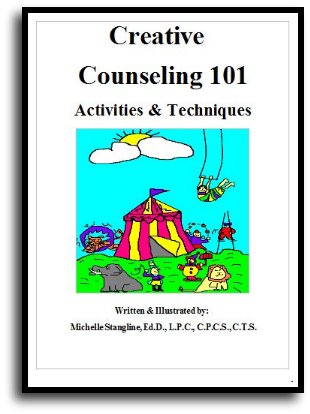
Step By Step Therapy:
Learn how to be a more Creative Therapist with the Book that started it all!
- Graduate School Counseling book used by hundreds of graduate counseling students!
- Includes full color reproducible worksheets with most activities.
- Winner of the Counselor Writer of the Year Award, 2011, Georgia Regional Award
Download Your Copy Today Only $39.95:
See Creative Counseling 101 eBook Information Here:
Get the Set
of all four
eBooks for only $98.95:
An incredible collection of how to do therapy eBooks!
A $159.80 Value,
You Save Over $60!
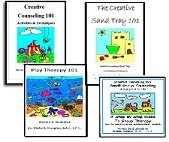
Get your complete set of the Creative Counseling 101.com eBooks by Dr. Michelle Stangline for only $98.95, that's less than $25.00 per eBook (Regular Price is $39.95 for each eBook.).
Your complete set includes:
- Creative Counseling 101
- Creative Group Counseling 101
- Creative Play Therapy 101
- Creative Sand Tray 101
For more information click the link below:
See Complete Set of eBooks For Sale Here:
New!!! "Beyond Art Therapy" 101 eBook
Over 300 pages of Beyond Art Therapy activities and techniques. Learn what I teach graduate counseling students!
See the link below for more information.
Only $39.95
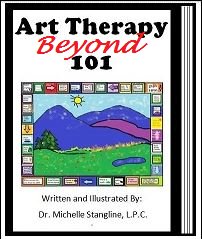
See More Invividual eBooks For Sale:
Sand Tray Therapy 101 eBook:
Learn how to do Sand Tray Therapy or enhance your skills.
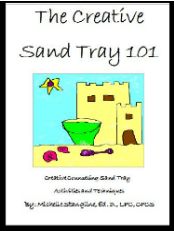
Play Therapy 101 eBook
Learn how to do play therapy or enhance your skills.
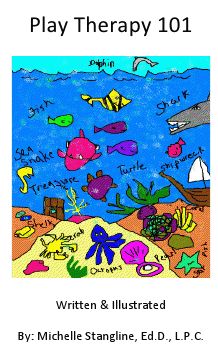
Small Group Counseling eBook For Sale:
Learn how to do creative group therapy and enhance your skills.
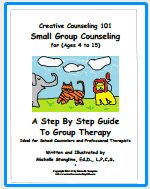
School Counselor Guidance Lesson & Social Stories eBook for sale:
Get a year's worth of school counselor guidance lessons with "Creative Warm & Fuzzy Classroom Guidance Lessons eBook". Introduce your students to the "Warm & Fuzzy Way". Click the link below for more information:
Warm & Fuzzy School Counselor Guidance Lessons eBook
